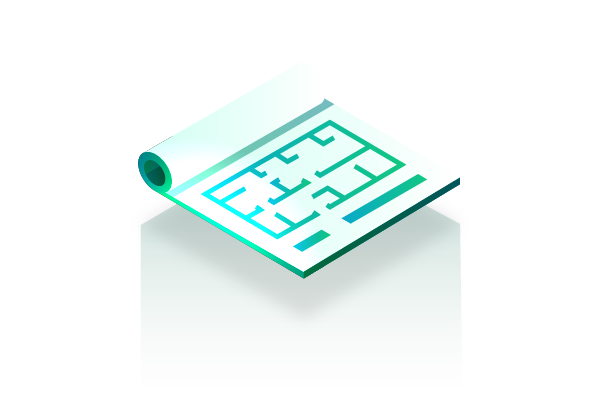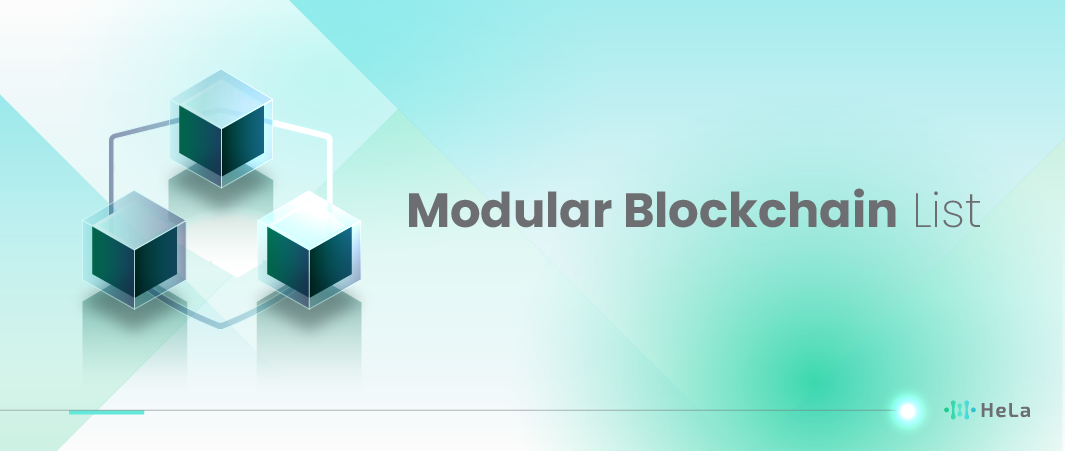As blockchain technology continues to evolve, modular blockchains are emerging as a game-changer in the industry. Unlike traditional monolithic blockchains, which handle execution, consensus, and data availability within a single system, modular blockchains separate these functions, allowing for greater scalability, flexibility, and efficiency. This innovative approach enables developers to build more specialized and interoperable blockchain networks, reducing congestion, lowering transaction costs, and improving overall performance.
With the demand for decentralized applications (dApps), DeFi, and Web3 solutions growing rapidly, modular blockchains are becoming the go-to choice for projects looking to optimize scalability without compromising security. As we enter 2025, several cutting-edge modular blockchain networks are shaping the future of blockchain infrastructure. In this article, we’ll explore 7 of the best modular blockchains to consider, each offering unique advantages that make them stand out in an increasingly competitive ecosystem.
The Evolution of Blockchain: From Monolithic to Modular
The transition from monolithic to modular blockchain architectures marks a significant evolution in the technology’s development. In the early days, blockchain was primarily about creating a tamper-proof ledger, where data integrity and security were paramount. These early blockchains were monolithic, meaning they were designed as single, indivisible entities where every component, from transaction processing to data storage, was tightly integrated. This design ensured a high level of security and trust, which was crucial for the adoption of blockchain in applications like cryptocurrencies.
However, as blockchain use cases expanded beyond simple transactions to complex applications in fields like finance, healthcare, and supply chain management, the limitations of monolithic architectures became increasingly evident. The main challenges were:
- Scalability: Monolithic blockchains struggle to handle a high volume of transactions efficiently. As every node in the network needs to process and validate every transaction, the system can become congested, leading to slow transaction times and high fees.
- Flexibility: In a monolithic structure, making changes or upgrades to the system can be cumbersome and risky. The interconnected nature of the components means that even small modifications require extensive testing and consensus, slowing down innovation and adaptation.
- Efficiency: Monolithic blockchains often require significant computational power and energy to maintain the ledger, making them less sustainable and more costly to operate in the long term.
Also Read: 7 Top of List Parallel EVM to Consider in 2025
In response to these challenges, the blockchain community began to explore modular architectures. Modular blockchains are designed with separation of concerns in mind. They break down the blockchain into distinct layers or modules, each responsible for a specific function. This modular approach offers several advantages:
- Improved Scalability: By decoupling the transaction processing layer from the data storage layer, modular blockchains can process transactions more efficiently. Techniques like sharding, where the transaction load is split among multiple smaller groups of nodes, further enhance scalability.
- Increased Flexibility: Modular structures allow for individual components to be updated or replaced without affecting the entire system. This fosters innovation, as developers can experiment with new algorithms or technologies in a specific module without overhauling the whole blockchain.
- Enhanced Efficiency: By optimizing each module for its specific function, modular blockchains can operate more efficiently. For instance, the consensus module can be designed to minimize energy consumption, while the storage module can focus on data compression and retrieval speed.
The shift from monolithic to modular is not just a technical upgrade; it reflects a deeper understanding of blockchain’s potential and the diverse needs of its users. As we continue to explore this technology’s possibilities, the evolution towards more sophisticated, modular designs is likely to continue, paving the way for more scalable, flexible, and efficient blockchain systems.
What is Modular Blockchain?

Modular blockchains represent a significant evolution in the blockchain architecture by deconstructing the traditional, monolithic structure into specialized components. Each module in this architecture focuses on a particular aspect of blockchain operations, enhancing the system’s overall efficiency, scalability, and flexibility. Here’s a closer look at the primary components:
Consensus Layer
This layer is responsible for achieving agreement on the state of the blockchain. It ensures all participants in the network agree on the same set of transactions and their order. By decoupling this layer from others, modular blockchains can utilize various consensus mechanisms best suited for their specific requirements, whether prioritizing speed, security, or decentralization.
Execution Layer
The execution layer is where the actual computation of transactions occurs. It’s responsible for executing smart contracts and processing transactions. By isolating this component, the blockchain can handle more complex operations or large volumes of transactions without burdening the entire network, leading to increased efficiency and faster processing times.
Data Availability Layer
This layer deals with storing and maintaining the blockchain’s data. It ensures that the data related to transactions and smart contracts is readily available to anyone in the network who needs it. This separation allows for optimizing data storage and retrieval processes, ensuring the blockchain’s integrity without sacrificing speed or inflating costs.
In modular blockchains, these layers can operate independently and even be located on different nodes or networks, bringing in a high degree of flexibility and specialization. This architecture allows for each layer to be optimized according to its specific function, potentially leading to a blockchain that is faster, more scalable, and more adaptable to various applications than traditional, monolithic blockchains.
7 Best Modular Blockchains to Consider in 2025

This section presents an exhaustive and current list of modular blockchains to watch in 2025. Each entry includes a brief overview of the platform, its unique features, and the specific problems it aims to solve within the blockchain domain. Here are seven modular blockchains in 2025 :
1. HeLa

HeLa, developed by HeLa Labs, stands out as a premier modular blockchain due to its focus on customizability, performance, and integration within the Web3 ecosystem. As a modular blockchain, HeLa separates its core functions—such as consensus, data management, and transaction processing—into distinct layers, allowing for highly adaptable and efficient operations. This layered structure enables HeLa to cater to diverse industries and use cases, from decentralized finance (DeFi) applications to enterprise-level blockchain solutions.
By providing a modular design, HeLa allows developers to build Web3 applications that can be tailored to specific performance requirements while still offering robust security and speed. Furthermore, HeLa is designed to support seamless interoperability, which facilitates integration with existing blockchain frameworks and encourages cross-chain collaboration. This adaptability makes HeLa an attractive choice for projects aiming to build scalable, interoperable, and customizable applications in 2025.
Key Features of HeLa as a Leading Modular Blockchain:
- Modular Architecture: Separates core functions into layers for optimized scalability, data handling, and efficiency.
- Customization for Web3 Applications: Allows developers to configure blockchain elements based on specific application needs, enhancing flexibility.
- Interoperability Focus: Supports cross-chain interactions, promoting integration with other blockchains and frameworks.
- High Performance: Balances speed and security to ensure quick transaction processing without compromising data integrity.
- Enterprise-Focused Solutions: Provides tools and resources for enterprise applications, making HeLa attractive for businesses and Web3 developers alike.
- Developer Tools and Ecosystem Support: Offers a range of tools and documentation to streamline development and integration
2. Celestia

Celestia is a groundbreaking modular data availability network, pioneering a new approach to blockchain infrastructure. Its core mission is to demystify and simplify the process of launching blockchains, making the technology more accessible, user-friendly, and adaptable to a wide range of needs. Celestia stands out in the Cosmos Ecosystem, not just for its innovative approach but also for its remarkable price performance, signaling strong market confidence and potential for growth.
The network’s architecture is designed to be lightweight yet powerful, ensuring that developers can focus on creating impactful applications without being bogged down by the complexities of underlying infrastructure. Celestia’s modular approach represents a paradigm shift in blockchain design, offering unparalleled flexibility, scalability, and user-centricity.
- Key Features: Specialized in data availability, flexibility with various execution layers, and improved scalability.
- Primary Use Cases: Decentralized applications, custom blockchain networks, and scalability solutions.
3. Arbitrum

Arbitrum has solidified its place among the best modular blockchains by offering a highly efficient Layer-2 scaling solution for Ethereum. Developed by Offchain Labs, Arbitrum leverages Optimistic Rollups to improve transaction throughput while maintaining Ethereum’s security and decentralization. With its modular approach, Arbitrum separates transaction execution from data availability, which enables it to achieve faster processing speeds and lower fees without overburdening the Ethereum mainnet.
This design makes Arbitrum highly attractive for decentralized finance (DeFi) applications and decentralized autonomous organizations (DAOs) that require low latency and cost-effective transaction processing. Arbitrum’s modular architecture is also developer-friendly, allowing for seamless interoperability with Ethereum smart contracts, which has driven significant adoption in the DeFi ecosystem. Given the increasing demand for scalable blockchain solutions that are both secure and affordable, Arbitrum’s modular blockchain design offers the ideal balance for projects needing Ethereum’s security but not its congestion and high fees.
Key Features of Arbitrum as a Leading Modular Blockchain:
- Optimistic Rollups: Utilizes Optimistic Rollups to achieve high throughput and low-cost transactions without compromising security.
- Layered Architecture: Separates transaction execution and data availability, allowing for faster processing and a more efficient blockchain experience.
- Ethereum Compatibility: Offers seamless compatibility with Ethereum smart contracts, making it easy for developers to deploy existing projects on Arbitrum with minimal changes.
- Enhanced Scalability: Scales Ethereum-based dApps, reducing congestion on the Ethereum mainnet and enabling higher transaction volumes.
- DeFi-Friendly Environment: Attracts numerous DeFi projects due to its low fees and fast transaction speeds, making it ideal for high-volume applications like decentralized exchanges (DEXs) and lending protocols.
- Developer Support: Arbitrum’s developer tools and resources make it easy to build, test, and deploy applications, encouraging rapid development and innovation.
4. Optimism

Optimism stands out as one of the most promising modular blockchains, offering a powerful Layer-2 scaling solution for Ethereum with a focus on reducing fees and enhancing throughput. Using Optimistic Rollups, Optimism effectively processes transactions off-chain and then submits the batched results back to Ethereum, dramatically decreasing the congestion and gas fees associated with Ethereum’s mainnet. With the recent Optimism Bedrock upgrade, Optimism has restructured its architecture to support modularity even more effectively.
Bedrock separates key blockchain functions, such as data availability and execution, into independent layers. This modular approach not only optimizes transaction processing and data handling but also improves cross-chain compatibility, making it easier for projects to interact with multiple blockchains. This adaptability has driven significant adoption among DeFi projects, NFT platforms, and decentralized applications (dApps), which require high performance and low fees. Optimism’s modular architecture further benefits developers, who can deploy Ethereum-compatible smart contracts with minimal changes, making it an ideal platform for Ethereum-native dApps looking for scalability and lower transaction costs.
Key Features of Optimism as a Leading Modular Blockchain:
- Optimistic Rollups: Processes transactions off-chain with Optimistic Rollups, which bundle transactions to reduce Ethereum mainnet congestion and lower gas fees.
- Optimism Bedrock: A modular upgrade that enhances efficiency by separating execution, data availability, and consensus into distinct layers, improving scalability and cross-chain interoperability.
- Ethereum Compatibility: Fully compatible with Ethereum smart contracts, allowing developers to deploy existing Ethereum dApps with minimal modifications and benefit from Ethereum’s robust security.
- Reduced Gas Fees: Optimism’s rollup design significantly reduces gas fees, making it ideal for cost-sensitive applications, including DeFi platforms and NFT marketplaces.
- Developer-Focused Resources: Offers extensive support for developers, including tools, documentation, and a vibrant community, fostering rapid innovation and ease of deployment.
- Community and Ecosystem Growth: Optimism’s commitment to building a collaborative community has led to strong partnerships and integrations within the Ethereum ecosystem, enhancing its appeal for developers and projects.
5. Manta Network
Manta Network has emerged as one of the leading modular blockchains in 2024, distinguished by its robust focus on privacy, scalability, and interoperability within the decentralized ecosystem. Built on a zero-knowledge proof (ZKP) framework, Manta Network leverages advanced cryptographic techniques to ensure that transactions remain confidential while maintaining the transparency and security inherent to blockchain technology. As a modular blockchain, Manta Network separates its core functionalities—such as data availability, execution, and consensus—into distinct layers, enabling enhanced performance and flexibility.
This separation allows developers to build privacy-preserving decentralized applications (dApps) without compromising on speed or scalability. Additionally, Manta Network’s seamless integration with other blockchains through its interoperability protocols facilitates cross-chain transactions and data sharing, making it an ideal platform for projects that require both privacy and connectivity. The network’s commitment to user-centric privacy solutions, combined with its scalable infrastructure, has attracted a wide range of applications, from private DeFi platforms and confidential NFT marketplaces to secure data sharing services.
Key Features of Manta Network as a Leading Modular Blockchain:
- Zero-Knowledge Proofs (ZKP): Utilizes advanced ZKP technology to ensure transaction privacy and confidentiality without sacrificing security or decentralization.
- Modular Architecture: Separates data availability, execution, and consensus into independent layers, enhancing scalability and allowing for specialized optimizations in each module.
- Interoperability Protocols: Enables seamless cross-chain interactions and data sharing with other blockchains, fostering a more connected and versatile blockchain ecosystem.
- Scalable Privacy Solutions: Provides high-throughput, low-latency transactions while maintaining strong privacy guarantees, making it suitable for a wide range of applications.
- Developer-Friendly Environment: Offers comprehensive tools, documentation, and support for developers to build and deploy privacy-focused dApps with ease.
- Decentralized Governance: Implements a robust governance model that allows the community to participate in decision-making processes, ensuring the network evolves in a decentralized and democratic manner.
- Private DeFi and NFT Support: Facilitates the creation of confidential decentralized finance platforms and non-fungible token marketplaces, enabling users to engage in financial activities and trade digital assets privately.
- Secure Data Sharing: Provides mechanisms for secure and private data exchange between parties, catering to applications that require confidentiality and integrity of information.
- Robust Security Framework: Maintains high security standards through continuous audits, formal verification of smart contracts, and proactive threat mitigation strategies.
- Active Community and Ecosystem: Boasts a vibrant and engaged community of developers, users, and partners that contribute to the network’s growth and innovation, driving widespread adoption and real-world use cases.
6. ZKsync

zkSync has emerged as one of the best modular blockchains in 2024, primarily for its focus on scalability, low-cost transactions, and enhanced privacy through zero-knowledge rollups (ZK-rollups). Developed by Matter Labs, zkSync’s modular approach allows it to optimize transaction execution and data availability independently, improving performance and making it highly adaptable to various use cases. zkSync leverages ZK-rollups to bundle and process multiple transactions off-chain while posting a concise proof back to the Ethereum mainnet, which verifies the transactions’ validity.
This approach not only reduces gas fees and transaction times but also maintains Ethereum’s security guarantees, making zkSync ideal for decentralized finance (DeFi) applications, NFT platforms, and other high-throughput dApps. With zkSync’s modularity, developers can build dApps that benefit from Ethereum’s security while avoiding its limitations, particularly the high fees and congestion.
Key Features of zkSync as a Leading Modular Blockchain:
- Zero-Knowledge Rollups (ZK-Rollups): Uses ZK-rollups to bundle and validate transactions off-chain, reducing transaction costs and times while maintaining high security and privacy.
- Ethereum Compatibility: zkSync supports Ethereum-compatible smart contracts, allowing developers to deploy Ethereum-native applications with minimal modifications, benefiting from Ethereum’s robust ecosystem.
- Low Gas Fees: The ZK-rollup structure significantly lowers transaction fees, making zkSync attractive for applications that require cost-efficient transactions, such as DeFi and micropayments.
- Enhanced Privacy: zkSync’s ZK technology not only improves efficiency but also introduces privacy benefits, allowing certain transaction details to remain confidential.
- Modular Architecture: Separates transaction execution and data availability, which optimizes scalability and makes zkSync adaptable to various blockchain needs and integrations.
- High Throughput: The system’s ability to handle a high volume of transactions per second (TPS) makes zkSync suitable for real-time applications, decentralized exchanges (DEXs), and NFT marketplaces.
- Developer Resources: zkSync provides comprehensive developer tools and resources, along with strong documentation, making it easier for teams to build, test, and deploy decentralized applications.
- Security: zkSync is built on Ethereum’s security foundation and undergoes rigorous audits and formal verification, ensuring robust protection against vulnerabilities.
- Ecosystem Growth: zkSync’s active community, partnerships, and integrations continue to drive adoption, attracting a wide range of dApps and users looking for scalable Ethereum solutions.
7. Osmosis

Osmosis has become one of the top modular blockchains in 2024, known for its specialized focus on decentralized finance (DeFi) and its robust interoperability within the Cosmos ecosystem. As a Layer-1 blockchain built with the Cosmos SDK, Osmosis employs a modular architecture that allows it to separate core blockchain functions, such as consensus, data availability, and transaction execution, into distinct layers. This approach enables Osmosis to scale efficiently while providing users with low-cost and high-speed transactions, essential qualities for DeFi applications.
Osmosis is specifically designed as an automated market maker (AMM) platform, optimized for liquidity pools, token swaps, and yield farming, which has led to a thriving DeFi ecosystem. Furthermore, Osmosis takes advantage of Inter-Blockchain Communication (IBC) to enable seamless cross-chain interactions with other blockchains within the Cosmos network, enhancing liquidity and expanding the platform’s utility.
This interoperability allows Osmosis users to trade assets across multiple blockchains, bringing greater flexibility to DeFi users and helping the platform attract a wide variety of DeFi protocols. Osmosis’s focus on providing a customizable, modular DeFi experience, along with its commitment to user governance, has positioned it as a leading choice for DeFi projects seeking scalability, cross-chain functionality, and low fees in 2025.
Key Features of Osmosis as a Leading Modular Blockchain:
- Modular Architecture: Separates key blockchain functions—consensus, data, and execution—into distinct modules, improving scalability and customization for DeFi applications.
- Automated Market Maker (AMM) Design: Optimized for liquidity pools, token swaps, and yield farming, making it a premier choice for DeFi projects and users.
- Cosmos SDK Integration: Built on the Cosmos SDK, Osmosis benefits from Cosmos’s secure, adaptable framework, enhancing its flexibility and development potential.
- Inter-Blockchain Communication (IBC): Enables seamless cross-chain transactions and interactions within the Cosmos ecosystem, increasing liquidity and expanding DeFi possibilities.
- Low Transaction Fees: Provides affordable transaction costs, which are crucial for high-frequency DeFi applications and accessible trading experiences.
- User Governance: Osmosis has a community-driven governance model, allowing token holders to participate in decision-making processes and shape the future of the network.
- Customization for Liquidity Providers: Offers customization options for liquidity providers, allowing them to set parameters such as swap fees, which enhances control over liquidity pool settings.
- Scalable DeFi Platform: Supports a high volume of transactions, making it suitable for large-scale DeFi applications and exchanges looking to avoid Ethereum’s congestion and high fees.
- Developer Support: Provides a robust set of tools and documentation for developers to create customized DeFi solutions, attracting a growing number of projects.
- Thriving DeFi Ecosystem: A wide array of DeFi projects and protocols are launching on Osmosis, creating a diverse and expanding ecosystem within the Cosmos network.
Modular Blockchains: Case Studies and Applications

In this section of the article, we delve into the practical applications and real-world case studies that demonstrate the power and versatility of modular blockchains. It’s time to move beyond theoretical discussions and explore how these modular blockchain systems are being effectively deployed across various industries, showcasing their adaptability and the tangible value they bring to the table.
- Supply Chain Management: One of the most compelling use cases for modular blockchains is in supply chain management. Consider a global pharmaceutical company that employs a modular blockchain system to track the production, distribution, and authentication of medications. This not only enhances transparency but also helps in ensuring the authenticity of pharmaceutical products, which is crucial for both regulatory compliance and patient safety.
- Smart Contracts in Real Estate: The real estate industry has seen a significant transformation with the introduction of modular blockchains. For instance, a property transaction can now be facilitated through smart contracts. This approach automates the entire process, from escrow to property transfer, reducing the need for intermediaries and streamlining the transaction, thereby saving time and cost for both buyers and sellers.
- Digital Identity Verification: In the realm of digital identity verification, modular blockchains have demonstrated their potential to combat identity theft and fraud. Financial institutions and government agencies are utilizing these systems to securely manage and verify customer identities. By distributing personal information across a decentralized network, individuals have more control over their data, and breaches become much harder to execute.
- Cross-Border Payments: The finance sector is witnessing the benefits of modular blockchains in cross-border payments. Traditional international transactions can be slow and costly due to multiple intermediaries and currency conversion. With modular blockchains, transactions can occur in near real-time, with reduced fees, making it an attractive solution for businesses involved in global trade.
- Healthcare Data Management: In the healthcare industry, patient data security and interoperability are paramount. Modular blockchains provide a secure and efficient way to manage electronic health records (EHRs). Patients can grant access to their medical data to authorized healthcare providers, enhancing collaboration and ensuring data integrity.
- Tokenization of Assets: Various industries, including art, real estate, and collectibles, are embracing tokenization of assets through modular blockchains. This allows for fractional ownership and trading of high-value assets, making it easier for individuals to invest in and trade assets that were once out of reach.
- Energy Grid Management: Utility companies are exploring the use of modular blockchains to optimize energy grid management. These systems enable real-time tracking of energy production and consumption, leading to more efficient distribution and reduced wastage.
- Food Traceability: In the food industry, consumers are increasingly concerned about the origin and safety of their products. Modular blockchains are being used to create transparent supply chains, allowing consumers to trace the journey of their food from farm to table. This enhances trust and safety in the food industry.
Also Read: 15 Best Blockchain Card Games with NFTs to Try in 2025
These case studies and applications demonstrate that modular blockchains are not just theoretical constructs but have real-world utility across a wide range of sectors. Their adaptability, security, and potential for cost savings make them a transformative technology with the capacity to revolutionize various industries. As technology continues to advance and more use cases emerge, we can expect modular blockchains to play an even more significant role in shaping our future.
Conclusion
In concluding, the exploration of modular blockchains is a testament to the relentless pursuit of innovation and improvement in the technology sector. As 2025 unfolds, keeping an eye on these developments is not just for tech enthusiasts or industry professionals, but for anyone keen on understanding the future of decentralized systems and their impact on various facets of our lives.
The modular blockchain is more than a technological breakthrough; it represents a new paradigm in our approach to digital trust, transparency, and collaboration. By embracing this evolution, we prepare ourselves to navigate and contribute to a future where technology aligns seamlessly with the complexities and demands of our modern world.
Disclaimer: The information provided by HeLa Labs in this article is intended for general informational purposes and does not reflect the company’s opinion. It is not intended as investment advice or recommendations. Readers are strongly advised to conduct their own thorough research and consult with a qualified financial advisor before making any financial decisions.

Joshua Soriano
I am Joshua Soriano, a passionate writer and devoted layer 1 and crypto enthusiast. Armed with a profound grasp of cryptocurrencies, blockchain technology, and layer 1 solutions, I've carved a niche for myself in the crypto community.
- Joshua Soriano#molongui-disabled-link
- Joshua Soriano#molongui-disabled-link
- Joshua Soriano#molongui-disabled-link
- Joshua Soriano#molongui-disabled-link

